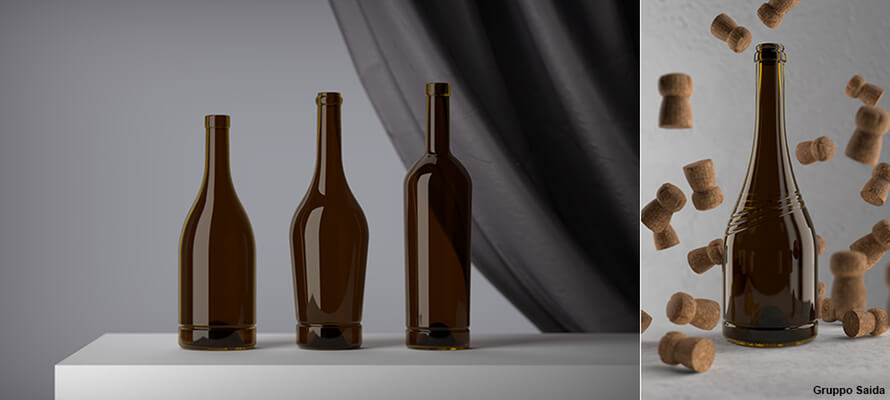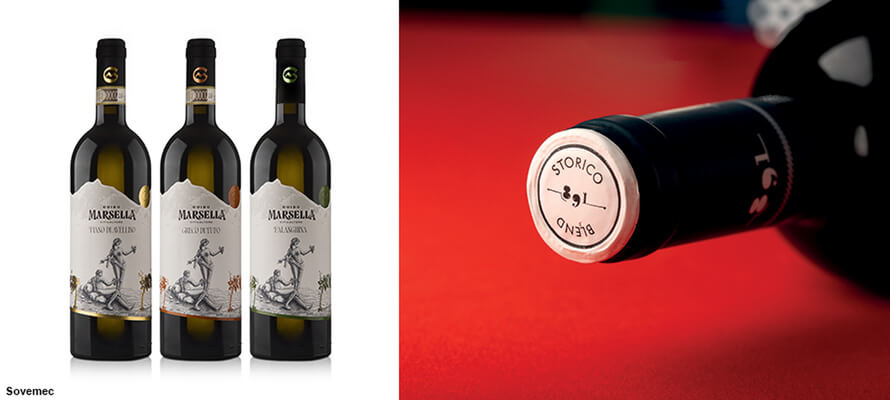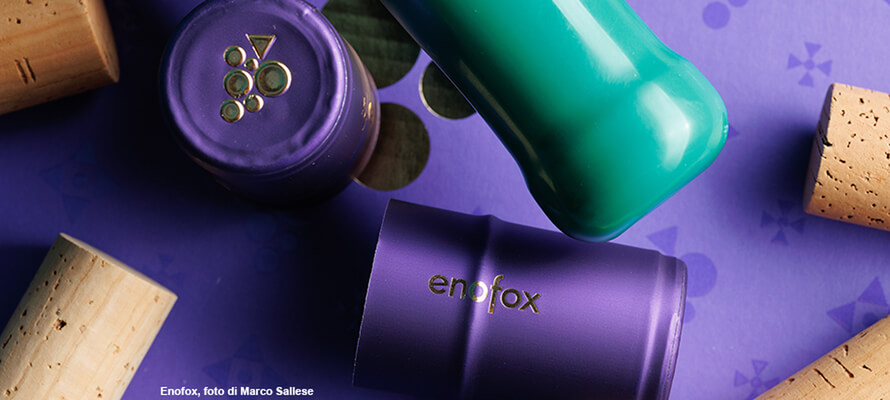How much you know about closures?
The closure system of a Wine & Spirits bottle is the meeting point between producer, brand and designer: this is where the perfect balance between functional and product safety requirements, production specifications and communication is played out. We talked about this with Enofox, Saida Group, O,Nice! Studio, So.ve.mec and Teo Italy.
By Roberta Ragona | PRINTlovers 103
If Veuve Clicquot is so recognisable, we certainly owe it to the yellow label introduced by the maison in 1876, but also to the monogram hot-embossed on the cork - created as an anti-counterfeiting measure - and the portrait of Madame Barbe-Nicole Ponsardin, widow of Clicquot, printed on the metal cap that seals the famous champagne. Such attention to detail is one of the first examples of wine communication, which makes it clear that the sealing system is a not insignificant aspect of packaging design in this segment.
In Italy, wine is one of the most crucial production items: in 2023, the UIV-ISMEA Observatory counted 118 IGT wines, 341 DOC wines, 78 DOCG wines, more than 255,000 producers for a total of 1 billion bottles sold via retail and large-scale distribution and more than 400 million consumed via hospitality and catering (Ho.Re.Ca). Each of these bottles needs a closure that respects the product’s organoleptic characteristics, protects its integrity and immediately conveys the producer’s identity.
Stoppers
The first step in choosing the proper closure has to do with wine production specifications, so the entire packaging system must guarantee a standard appropriate to its contents: resistance to pressure in the case of sparkling and semi-sparkling wines, the right level of micro-oxygenation or - vice versa - complete sealing of the product from external agents, both light and atmosphere. Most producers also refer to the standards of Cetie, a voluntary certification body for glass and PET packaging, which cover many aspects, from the design of the mouthpieces to the sealing systems.
The most common bottles for still wines are Bordeaux, Burgundy, Rhine and Alsace, for which a cork stopper is generally used. Since bio-agglomerate or extruded plastic corks also became available, cork is no longer an option. So, one-piece cork becomes the choice for high-end wines, while micro-agglomerated cork stoppers are the norm for consumer products. On the printing side for cork, the most common option remains hot stamping, which, from analogue clichés, has been enriched by laser stamping systems that, in addition to extreme precision, enable the use of variable data. This method opens up exciting opportunities for customisation and anti-counterfeiting: numbering each cork stopper with an individual code helps prevent fraud, allowing the individual bottle to be traced. Cork stoppers encapsulated in wood, glass or metal, however, are more commonly used for meditation wines and spirits, whose bottles are uncorked and re-capped to serve smaller quantities of product. In the case of encapsulated corks, printing technologies are growing exponentially: all the techniques used for flat printing on wood, glass, and metal are also available for corks.
Caps
The most popular choice for protecting the stopper is the capsule. The relationship between bottle mouth, stopper and capsule is the focus of research by glassworks and capsule producers to convey the experience of good drinking through design. Gian Luca Zuccarello, Commercial Manager of the Gruppo Saida, which has been involved in the production, marketing and distribution of glass containers for food since 1958, explains how this dialogue between form and function is always ongoing: “Bottle design must meet rigorous functional criteria, but it is also made up of details that contribute to building the product experience. Just think that between two people sitting at the table, the neck of the bottle will always be at eye level, so a precisely cut capsule, a graphic or a finishing at the height of the mouth are always on the gaze”s horizon”. An example of this attention to the relationship between the three elements is the banded mouths of the so-called “Sommelier” model: a cleanly designed mouth to which the capsule adheres completely, remaining perfectly cylindrical, and whose smooth surface is marked by a single groove on the neck that indicates where to cut the capsule.
The most commonly used materials in capsule production are PVC, polylaminate and PET. PET can be produced from recycled plastic, which is why it is growing in importance. PET from recycled plastic tends to be less colourful than PVC, but in recent years, designers have enhanced this quality by contrasting it with gold, silver or shiny foil effects. Besides the availability of the raw material, the choice in terms of closures is divided between materials that can be processed in the printing plant and those that must be processed directly in the cellar. So, it becomes a matter of the machinery available to the wineries, and the choice of one capsule over another depends on the production investments made and the ability to upgrade technology. PVC uses different machinery than polylaminate; whereas PVC is shrinkable and therefore fits the neck of the bottle, polylaminate is “screwed” onto the neck. PET, conversely, can be processed with minor adaptations with the same machinery that processes PVC, making it easier to switch to recycled material.
The match between the label and the capsule is a vital aspect to address from the project”s start. So.ve.mec, a company specialising in high-end label printing, has internalised the capsule production chain. Antonella Coppola, the company’s Marketing Manager, explains: “Working with customers on bottle design, we were often faced with the difficulty of matching the colours chosen for the paper labels and those for the capsules. By managing the production of both products in-house and using the colour range of the capsule materials as a guide, we can work on optimising colours, textures and paper materials until a perfect match is achieved. A team of specialised technicians takes care of these optimisations, resulting in an overall design that is an added value for customers, especially for high-end products”.
However, in the case of Teo Italy - the Italian subsidiary of the Ukrainian multinational Technologia JSC, which produces food packaging for the Wine & Spirits sector - the route was the other way round: to transport the know-how and materials used for capsules and large capsules into labels. Giovanni Cartasegna, General Manager, explains: “In addition to the traditional paper labels, the offering of premium labels in aluminium and metal polylaminate allows a strong aesthetic consistency of the product both in terms of material and embossing and engravings, which reach a level of detail that is difficult to equal on paper. This new material - derived from decades of experience with polylaminate capsule technology - also makes it possible to replace traditional pewter labels (a tin alloy cast in engraved iron or brass shapes) with aluminium, which is completely recyclable, cheaper and easier to process”. This innovation has been transferred from the world of sparkling and still wines to the world of spirits, where the design language is more open to experimentation with materials and techniques. As far as finishings are concerned, the first choice of producers and designers remains foil, in particular gold and silver hot stamped on the capsule material, and embossing.
But capsules do not only have an aesthetic function: until a few years ago, it was compulsory to insert on the capsule the ICQRF code (Central Inspectorate for the Quality Protection and Fraud Repression of Agri-Food Products - the European control body for agri-foodstuffs), which was to identify the bottling company registered in the SIAN, the unified information system of the Ministry of Agricultural, Food and Forestry Policies. As Marco Cateni, founder of Enofox, an agency specialising in the wine and food & beverage sector, points out: “By leaving designers free to use the entire capsule as a natural extension of the label design, we can focus on the communication aspect of packaging, with elements communicating with each other. Not only do the capsules fulfil their primary purpose, i.e. to provide an additional level of protection from dust and other external agents and a guarantee by the producer of the quality of the product, but they also reinforce an aspect of brand communication because wine is, after cosmetics, one of the sectors that works most on packaging for brand identity. Many capsules, particularly those made of polylaminate, have in recent years been fitted with tabs to facilitate opening and make any attempts at tampering or compromising their integrity obvious. However, the guarantee seal has become such a part of the perceived image that - like other security elements of the past no longer in use, such as string and sealing wax closures - it has sometimes been retained with an aesthetic function through seals made of fine, textured, adhesive or holographic effect papers.
Cages and caps
Another functional element that has become a design playground is metal cages and caps for sparkling wines, whose closures must withstand at least 3 bar internal pressure, up to 12 bar at peak fermentation. These elements show more and more imaginative solutions: from the coloured wire of the cages that has expanded the choice over the classic gold and silver to the caps that have only been enriched with embossing, colour prints, lithographic prints, soft touch and crackle effect varnishes, UV inks, up to fine details such as the printing on the inside of both brand elements and progressive numbering to trace products along the supply chain. A curious presence that has come to the fore in recent years is the arrival of the crown cap in bottles destined for sales channels. The crown cap has always been commonly used for bottling and is of fundamental importance in bottle fermentation, but its presence in distribution channels is mainly linked to the expansion in the market for so-called natural wines. At present, there is no unambiguous legislation in the EU on the exact definition of “natural wine”, but there is a galaxy of small winemakers who produce according to their specifications. Perhaps also because of this evolving wine language or a more niche target audience, even in product design, these wines often move away from the visual codes of heritage wines and experiment with languages that draw on the experience of related sectors such as craft and independent breweries.
The future of closures
There are three especially promising innovations: paper capsules, the use of aluminium and the expansion of the possibilities of glass stoppers. In all three cases, there is a move towards greater sustainability in terms of material lightening and end-of-life management. The area where the challenge to consumer habits is most measured is the screw cap sector. BVS and WAK are the two most widespread standards for screw caps. They are available with a variety of seals with different OTR values, i.e. the measure of the oxygen permeability of the cap, making them suitable for young, classic, and even sparkling wines. Made of aluminium, they are easily recyclable and can be printed with various technologies, such as offset, screen printing, digital printing, side and three-dimensional head embossing, inks including glitter, hot foil, and matt and gloss metallisation.
Stefano Torregrossa, founder of O,Nice! Studio, comments: “While in countries with a wine tradition further away from the cork-producing areas, such as the United States, Canada, Northern Europe, Australia and New Zealand, BWS is already the standard - in traditional wine-producing regions such as Italy and France, the resistance to the use of screw caps is a mix of stringent rules and consumer habits. Yet, according to some experts, aluminium packaging would allow greater insulation of the product from external agents in cases where this is required so that the wine arrives on the table as the winemaker conceived it in the cellar. In general, aluminium is a strong trend in markets other than Italy, as are formats other than 75 cl. I followed a design project for a client in Germany that makes 20 cl aluminium bottles painted gold with a screw cap. They have significant sales volumes. Could it work on the Italian market? It’s hard to say, but I believe we should stop assuming that consumers cannot embrace innovation. Probably, if brands, communicators, designers, distributors, manufacturers themselves and their consortia explored these solutions, the market would follow them, as it has adapted to so many innovations that until a few years ago seemed unimaginable.”
“Glass closures, on the other hand,” Torregrossa concludes, “are already part of the offering of some glassworks, but the limits of current use concern the need to certify and guarantee adherence to standards. There is also a cost issue, so glass capping is currently the preserve of very high-end products. But the high-end is also the sector that can afford to experiment more with creativity and pave the way for technological innovations that can then be extended to the market as a whole.”





